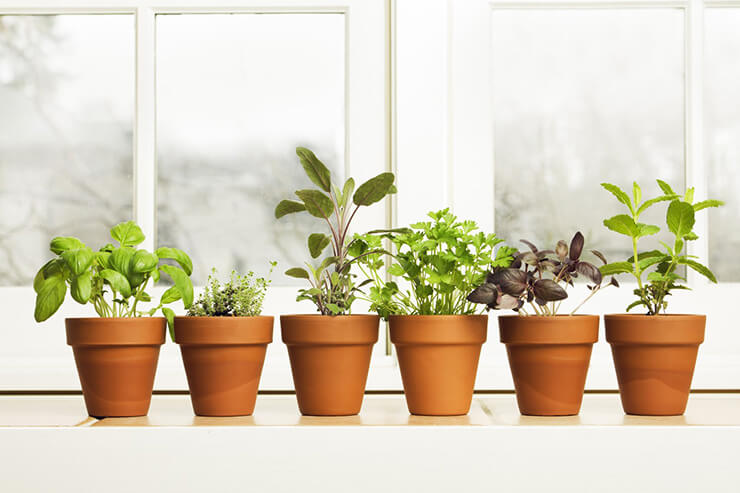Indoor gardening may seem like a modern phenomenon—a photo-worthy fusion of greenery and lifestyle design—but its roots stretch far deeper into American history than most people realize. From colonial window boxes to space-age hydroponics, the story of indoor gardening in the United States is a tale of ingenuity, resilience, and a persistent desire to bring nature inside.

Seeds of the Past: Early Indoor Gardening Traditions
Colonial America and the Basics
Indoor gardening in early America was largely utilitarian. During colonial times, settlers
brought with them European practices of keeping herbs and medicinal plants close at hand —herbs like thyme, rosemary, and chamomile. These plants weren’t for show—they were essential for cooking, treating ailments, and sometimes preserving food. Windowsill gardening was especially common in northern colonies where Winters were harsh. When gardens were buried in snow, a few hardy herbs in the kitchen could brighten up Winter meals.
Victorian America and the Rise of Ornamentation
As the 19th century progressed, indoor plants began to take on a more decorative role in American households. The Victorian era brought a love for the exotic, and the wealthy began to fill their parlors with ferns, palms, and flowering plants like orchids and begonias. These plants were often displayed in ornate containers or placed in specialized rooms known as conservatories—glass-enclosed spaces where warmth and light could support tropical growth. The emphasis shifted from purely functional herbs to ornamental and status-symbol plants. For many, cultivating greenery indoors became a way to demonstrate refinement, education, and worldly taste.
Indoor Gardening in the 20th Century: From Necessity to Hobby
The Great Depression and Victory Gardens While not strictly indoor gardening, the idea of growing food at home has gained national traction during times of crisis. In the 1930s and again during World War II, Americans were encouraged to plant “Victory Gardens” to supplement their rations and ease demand on the nation’s food supply.
Indoor gardening, though limited during these periods, served as an extension of this philosophy in urban environments where outdoor space was scarce. People grew lettuce in pots on fire escapes, sprouted beans on windowsills, and nurtured tomatoes in containers near sunlit windows. The message was simple: if you could grow it yourself, you should.
Post-War Suburbia and Houseplants
After the war, indoor gardening shifted once again toward aesthetics and lifestyle. The rise of suburban living, along with the growth of the middle class, brought houseplants into nearly every American home. Snake plants, spider plants, and philodendrons became indoor staples during the 1950s and 1960s, thanks to their hardy nature and low maintenance requirements.
Houseplants were now less about survival and more about beauty, air purification, and interior design. Still, the idea of growing food indoors never fully disappeared—it simply went dormant for a while.
The Counterculture and the Green Movement
The 1970s: Back to the Land, Inside the House During the 1970s, the environmental movement sparked renewed interest in self sufficiency and organic food production. This was the era of Earth Day, Whole Earth Catalogs, and an explosion of DIY culture. Indoor gardening found a new niche among people who wanted to reconnect with the land—even if they lived in apartments.
Books like The Indoor Gardener’s Handbook offered guidance on growing everything from herbs to dwarf fruit trees indoors. Macramé plant hangers dangled from ceilings, and sunny windows became sanctuaries for greenery.
People began to explore hydroponics more seriously, using early systems to grow lettuce, herbs, and even strawberries indoors without soil. These were often homemade setups using aquarium pumps, PVC pipe, and nutrient solutions mixed in bathtubs or buckets.
The Tech Boom and Modern Indoor Gardening
The 1990s-2000s: Gadgets, Grow Lights, and Urban Living As technology advanced, so did indoor gardening tools. The 1990s and early 2000s saw an uptick in indoor gardening fueled by innovations in lighting, automation, and compact growing systems.
Fluorescent grow lights became more accessible, offering affordable supplemental lighting that mimicked sunlight. Indoor grow tents entered the scene, allowing hobbyists to control temperature, humidity, and light with increasing precision. Meanwhile, urban living was on the rise. As more Americans moved to cities, growing food indoors was appealing for both its practicality and as a creative outlet. Container gardening gained popularity, and windowsill herb kits became common gifts for foodies and apartment dwellers alike.
Hydroponics and Aeroponics
The 21st century ushered in the refinement of soil-less gardening methods. Hydroponics (growing plants in nutrient-rich water) and aeroponics (growing plants with roots suspended in mist) moved from commercial greenhouses into homes. Early adopters and DIY enthusiasts set up these systems in spare rooms and closets, achieving remarkable yields in small spaces.
Systems like the AeroGarden, introduced in the early 2000s, brought hydroponics to mainstream consumers with compact, all-in-one kits. These kits came with pre-seeded pods, built-in LED lights, and automatic watering—a “plug-and-play” indoor gardening experience.
The Pandemic Gardening Boom
In 2020, the COVID-19 pandemic ignited a dramatic surge in interest in both indoor and outdoor gardening. With grocery store shelves occasionally empty and people spending more time at home, growing food indoors became more than a hobby—it became a form of resilience and therapy.
Seeds, starter kits, and hydroponic systems sold out nationwide. Families grew lettuce in mason jars, sprouted scallions in water glasses, and began experimenting with vertical garden walls and grow towers.
Indoor gardening provided comfort, nourishment, and control during a time of uncertainty. It reintroduced people to the joy of watching something grow—and the satisfaction of eating it.
Why Indoor Gardening?
Space Constraints
One of the main reasons people choose indoor gardening is simple: not everyone has a yard. City dwellers, renters, and people with shared outdoor spaces often turn to indoor setups to grow what they can, where they can.
Indoor gardening eliminates the need for land. You don’t have to worry about poor soil, pests like rabbits or deer, or unpredictable weather. It gives people with limited space full access to the joys of gardening.
Year-Round Access
Outdoor gardening is seasonal. Indoor gardening is not. With proper lighting and temperature control, you can grow lettuce in December or strawberries in February. This makes it especially appealing in regions with harsh Winters or extreme Summer heat.
Environmental Control
Indoors, you’re in charge. From humidity and temperature to pests and pollination, you can control every variable. Indoor gardening can mean consistency—and often higher yields per square foot than traditional outdoor gardens.
Aesthetic and Emotional Benefits
For many, indoor gardening isn’t just about food. It’s about joy. Plants beautify your space, improve air quality, and reduce stress levels. They help us feel connected to nature—without having to worry about bugs or sunburn.
Tools and Techniques: Then and Now
While indoor gardening has been popular for hundreds of years, some tools and techniques have changed over time.
| Era | Tools & Techniques | Notable Features |
| Colonial | Window boxes, clay pots, hand-tended herbs | Cooking & medicinal use |
| Victorian | Conservatories, ornate planters | Aesthetic focus, exotic plants |
| 1970s | DIY hydroponics, fluorescent lights | Self-sufficiency, experimentation |
| 1990s | Compact grow lights, early automation | Urban applications, efficiency |
| 2000s | AeroGardens, digital timers, LEDs | Smart gardening, mainstream appeal |
| 2020s | App-connected systems, AI optimization, vertical gardens | Tech-integrated, high-density, year round gardening |
The Future of Indoor Gardening
Today, the line between gardening and technology continues to blur. Smart gardens now offer app-based monitoring for light, moisture, and nutrient levels. AI systems can optimize growth cycles for individual plants. Some companies are developing fully enclosed indoor greenhouses that can grow food using solar power and recycled water. Urban agriculture is also on the rise, with restaurants, schools, and even office buildings installing living walls, vertical farms, and hydroponic systems to supply fresh produce on site.
But despite all the innovation, the heart of indoor gardening remains unchanged: it’s about growing something, nurturing it, and benefiting from what it gives back—whether it’s a leaf of basil or a full tomato harvest. So, whether you’re hanging herbs in a sunny window, experimenting with grow lights, or building a salad wall in your kitchen, indoor gardening can be very satisfying on many levels.


 Previous
Previous

